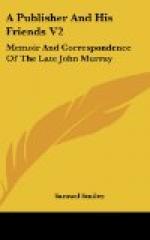“I have lately ventured on the bold step of quitting the old establishment to which I have been so long attached, and have moved to one of the best, in every respect, that is known in my business, where I have succeeded in a manner the most complete and flattering. My house is excellent; and I transact all the departments of my business in an elegant library, which my drawing-room becomes during the morning; and there I am in the habit of seeing persons of the highest rank in literature and talent, such as Canning, Frere, Mackintosh, Southey, Campbell, Walter Scott, Madame de Stael, Gifford, Croker, Barrow, Lord Byron, and others; thus leading the most delightful life, with means of prosecuting my business with the highest honour and emolument.”
It was in Murray’s drawing-room that Walter Scott and Lord Byron first met. They had already had some friendly intercourse by letter and had exchanged gifts, but in the early part of 1815 Scott was summoned to London on matters connected with his works. Mr. Murray wrote to Lord Byron on April 7:
“Walter Scott has this moment arrived, and will call to-day between three and four, for the chance of having the pleasure of seeing you before he sets out for Scotland. I will show you a beautiful caricature of Buonaparte.”
Lord Byron called at the hour appointed, and was at once introduced to Mr. Scott, who was in waiting. They greeted each other in the most affectionate manner, and entered into a cordial conversation. How greatly Mr. Murray was gratified by a meeting which he had taken such pains to bring about, is shown by the following memorandum carefully preserved by him:
“1815. Friday, April 7.—This day Lord Byron and Walter Scott met for the first time and were introduced by me to each other. They conversed together for nearly two hours. There were present, at different times, Mr. William Gifford, James Boswell (son of the biographer of Johnson), William Sotheby, Robert Wilmot, Richard Heber, and Mr. Dusgate.”
Mr. Murray’s son—then John Murray, Junior—gives his recollections as follows:
“I can recollect seeing Lord Byron in Albemarle Street. So far as I can remember, he appeared to me rather a short man, with a handsome countenance, remarkable for the fine blue veins which ran over his pale, marble temples. He wore many rings on his fingers, and a brooch in his shirt-front, which was embroidered. When he called, he used to be dressed in a black dress-coat (as we should now call it), with grey, and sometimes nankeen trousers, his shirt open at the neck. Lord Byron’s deformity in his foot was very evident, especially as he walked downstairs. He carried a stick. After Scott and he had ended their conversation in the drawing-room, it was a curious sight to see the two greatest poets of the age—both lame—stumping downstairs side by side. They continued to meet in Albemarle Street nearly every day, and remained




